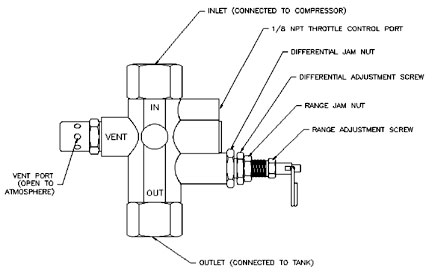Drain-All Condensate Traps
- How do I install the Drain-All condensate trap?
Download the instruction manual







Download the instruction manual
Please contact us and we will put you in touch with a distributor in your area.
The flow capacity charts for all of our safety valves are shown in the "Drawings and Documentation" section under the safety valves product pages.
Control Devices offers two standard types of pressure relief devices for air.
A safety relief valve, or pop-off valve, is set to a predetermined pressure using a spring force to counteract the air pressure force. When the force created from the air pressure becomes greater than the spring force, the valve ‘pops’ fully open and vents air to the atmosphere. Safety relief valves are sized in such a manner that the valve will always have a greater flow capacity than the source creating the air pressure (i.e. an air compressor). The valve will remain open until a reseat pressure is reached. This reseat pressure varies with valve type and is usually between 35% to 75% of the set pressure. Control Devices has eight series of valves that are manufactured in accordance with Section VIII of the ASME Boiler and Pressure Vessel Code. We also manufacture a wide range of non-code valves. See our Products section for information on the valve types.
A relief valve is set to a predetermined pressure with a spring force counteracting the force created by the pressure from the air. When the force created from the pressure of the air becomes greater than the force of the spring, the valve will start to open and flow to atmosphere. As the pressure continues to increase, the valve will open further, allowing more flow. As the pressure decreases, the valve will close near the pressure at which it opened.
Download the engineering information.
As a general statement, all of our check valves have a cracking pressure of 3 PSI or less. However, most check valves under 1/2" NPT have a cracking pressure of less than 1 PSI. If you need more detailed data for a particular check valve, or have a specific requirement, please feel free to contact us.

Cut-out pressures are adjustable from 60 PSI to 250 PSI with the standard silver spring. The differential (difference between cut-out and cut-in pressures) is typically set at the factory at roughly 15% of the cut-out pressure. This is usually a suitable differential and will not normally need to be readjusted.
Adjustment Procedure (refer to Figure 1):
Control Devices offers a wide range of pilot valves and unloading valves for many applications:
Pilot Valve
The P25 valve is an adjustable pilot valve with a 1/4" NPT inlet and an 1/8" NPT outlet port which can be used to pilot head unloaders or used with a throttle control to slow down the engine during cut out. The P25 pilot valve has a 3/8-16 UNC mounting boss, and comes standard with an unloading sleeve for gas engine warm up. Options include a toggle for one hand unloading, a lock out thumbscrew for dual systems control, and a 1/4" nipple for the inlet. Refer to the Pilot Valve section of our Products web page for details on the cut-in and cut-out ranges.
Venting Pilot Valve
The P25V unloader incorporates all of the P25 options along with a vent valve to unload the compressor discharge after cut-out. The vent valve on the P25 has a 1/4" compression fitting which must be connected to the compressor discharge line. The P25V offers all of the same options as the P25, except for the mounting boss.
Venting Unloader with Check Valve
Control Devices offers a complete line of self-contained Continuous Run Vent unloaders. These valves incorporate an adjustable pilot valve, vent unloader, and check valve that perform all of the functions required for continuous run compressors. Options include a 1/8" NPT tapped port for throttle control of a gas engine, a toggle unloading lever for one-hand warm up, and a vent port muffler. Depending on flow and space requirements, Control Devices offers the Mark II, Mark III, and Mark IV series of valves. Visit the Products section of our web site to find out which valve is right for you.